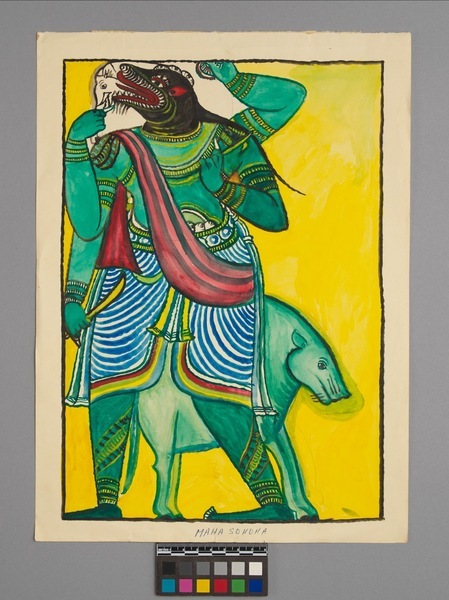Maha Sohona Item Number: 3392/14 from the MOA: University of British Columbia

Description
A watercolour painting which depicts a spiritual being with four arms and an animal-like head. The being has a black head and green body. It is wearing a blue skirt that ends just below the knee. The bottom of the skirt has a border made up of red, blue, yellow, and green horizontal stripes. The main body of the skirt is covered in thinner horizontal stripes, and consists of two pieces which come together in the front. A piece of fabric hangs down from the waistband, which is decorated with a repeating circular pattern. A red, striped sash is draped diagonally across the being's chest. Additional adornments wrap around its chest and neck, and decorative bands encircle its biceps, wrists, and legs. The being's head is elongated, and facing to the left. It has two eyes stacked vertically above an open mouth. Its lower jaw is filled with sharp teeth. The being has a pointed, red ear on the side of its head, and three white bumps on top. A long black tail extends behind the head and across its shoulder. One of the being's arms is holding an elephant head by the trunk. The other arms are holding a round, red and green object, a small, thin blade, and a slightly larger curved blade. There is an animal standing behind the being. The animal is green, with a large, round body, a long face, hooves, and whiskers. The painting's background is bright yellow, and a rectangular black border surrounds the image. There is a unpainted section behind the being's head and shoulders.
History Of Use
The imagery is associated with ritual healing in Sri Lanka. The set of watercolours (3392/3-34) is said to depict spirits that inhabit planets, or deviyo (minor gods) or rakshas and yakkas (evil or mischievous beings). These beings are often depicted in masked dances and exorcisms.
Iconographic Meaning
Represents Maha Sohona, a demon.
Narrative
The collector, Dr. Egan, wrote his doctoral thesis on healing rituals in Sri Lanka. His fieldwork was carried out in the south of Sri Lanka, in the village of Kadurupokuna, near the town of Tangalla (Hambantota District), between Sept. 1965 and Nov. 1966. His thesis documents a Sinhalese healing ritual, the Maha Sohona (or Maha Sona) Sumayama (the time when the demon Maha Sohona appears), performed on August 18, 1966, in the Berava drummer hamlet, in the village of Kadurupokuna.
Item History
- Made in Sri Lanka between 1960 and 1966
- Collected between 1965 and 1966
- Owned by Michael John Egan before 1977
- Owned by Carol Egan before October 2, 2019
- Received from Carol Egan (Donor) on October 2, 2019
What
- Name
- Maha Sohona
- Identification Number
- 3392/14
- Type of Item
- painting
- Overall
- height 37.5 cm, width 27.2 cm
Who
- Culture
- Sinhalese
- Previous Owner
- Michael John Egan and Carol Egan
- Received from
- Carol Egan (Donor)
Where
- Holding Institution
- MOA: University of British Columbia
- Made in
- Sri Lanka
When
- Creation Date
- between 1960 and 1966
- Collection Date
- between 1965 and 1966
- Ownership Date
- before 1977 and before October 2, 2019
- Acquisition Date
- on October 2, 2019
Other
- Item Classes
- paintings; works on paper
- Condition
- good
- Accession Number
- 3392/0014